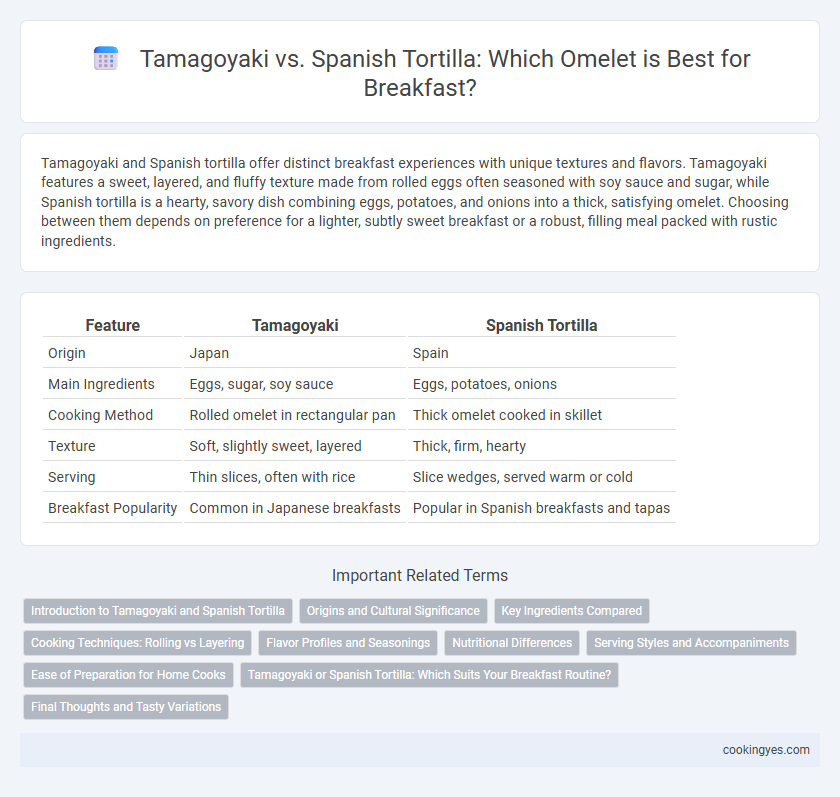Tamagoyaki and Spanish tortilla offer distinct breakfast experiences with unique textures and flavors. Tamagoyaki features a sweet, layered, and fluffy texture made from rolled eggs often seasoned with soy sauce and sugar, while Spanish tortilla is a hearty, savory dish combining eggs, potatoes, and onions into a thick, satisfying omelet. Choosing between them depends on preference for a lighter, subtly sweet breakfast or a robust, filling meal packed with rustic ingredients.
Table of Comparison
| Feature | Tamagoyaki | Spanish Tortilla |
|---|---|---|
| Origin | Japan | Spain |
| Main Ingredients | Eggs, sugar, soy sauce | Eggs, potatoes, onions |
| Cooking Method | Rolled omelet in rectangular pan | Thick omelet cooked in skillet |
| Texture | Soft, slightly sweet, layered | Thick, firm, hearty |
| Serving | Thin slices, often with rice | Slice wedges, served warm or cold |
| Breakfast Popularity | Common in Japanese breakfasts | Popular in Spanish breakfasts and tapas |
Introduction to Tamagoyaki and Spanish Tortilla
Tamagoyaki is a Japanese rolled omelet made by layering seasoned beaten eggs, typically flavored with soy sauce, mirin, and sugar, resulting in a sweet and savory taste. Spanish Tortilla, also known as tortilla espanola, is a traditional Spanish dish consisting of eggs, potatoes, and onions cooked slowly to create a thick, hearty omelet. Both omelets offer unique textures and flavors, with Tamagoyaki being light and fluffy, while Spanish Tortilla is dense and filling, making them popular breakfast choices worldwide.
Origins and Cultural Significance
Tamagoyaki, a Japanese rolled omelet, traces its origins to the Edo period, symbolizing precision and subtle sweetness in Japanese cuisine. The Spanish Tortilla, often called Tortilla Espanola, originated in Spain's Castilla region during the 19th century, celebrated for its hearty combination of eggs, potatoes, and onions. Both dishes reflect their cultural heritage: Tamagoyaki embodies Japanese technique and balance, while the Tortilla Espanola serves as a staple of Spanish social gatherings and regional identity.
Key Ingredients Compared
Tamagoyaki features thin layers of seasoned eggs rolled with sugar, soy sauce, and mirin, creating a slightly sweet and savory flavor profile. Spanish Tortilla consists primarily of eggs, potatoes, and onions, pan-fried to form a thick, hearty omelet rich in texture. The contrast lies in Tamagoyaki's delicate sweetness and rolling technique versus the Spanish Tortilla's rustic, dense composition emphasizing starchy potatoes.
Cooking Techniques: Rolling vs Layering
Tamagoyaki is crafted by skillfully rolling thin layers of seasoned egg in a rectangular pan to create a delicate, slightly sweet omelet with a smooth texture. In contrast, the Spanish tortilla is prepared by layering thick slices of potato and onion within beaten eggs, then slowly cooking the mixture to form a dense, hearty omelet with a firm consistency. These distinct cooking techniques--rolling versus layering--define the unique textures and flavors characteristic of each breakfast dish.
Flavor Profiles and Seasonings
Tamagoyaki features a delicate balance of sweetness and umami from dashi, soy sauce, and mirin, creating a savory yet subtly sweet flavor profile distinct in Japanese cuisine. Spanish Tortilla relies on rich, earthy notes from slow-cooked potatoes and onions, seasoned with sea salt and occasionally smoked paprika, delivering a hearty and robust taste. Both omelets offer unique seasoning approaches that reflect their cultural origins, with Tamagoyaki emphasizing light, layered flavors and Spanish Tortilla highlighting rustic, comforting seasoning.
Nutritional Differences
Tamagoyaki and Spanish tortilla offer distinct nutritional profiles for breakfast, with tamagoyaki typically being lower in calories and fat due to its lighter use of oil and inclusion of sweetened eggs, while Spanish tortilla is richer in protein and fiber because of the addition of potatoes and sometimes onions. Tamagoyaki provides essential amino acids and moderate vitamin A content from eggs, whereas Spanish tortilla supplies complex carbohydrates and potassium from potatoes, contributing to sustained energy release. Choosing between the two depends on dietary goals: tamagoyaki suits low-calorie or protein-focused diets, whereas Spanish tortilla supports higher energy and fiber needs.
Serving Styles and Accompaniments
Tamagoyaki, a Japanese rolled omelet, is typically served sliced into delicate rectangular pieces, often accompanied by grated daikon and soy sauce for a subtle, savory flavor profile. Spanish Tortilla, a thicker, hearty omelet made with potatoes and onions, is usually cut into wedges and paired with crusty bread or a fresh salad, offering a more filling breakfast option. Both dishes highlight regional tastes and presentation preferences, enhancing their unique roles in traditional breakfast settings.
Ease of Preparation for Home Cooks
Tamagoyaki requires a specific rectangular pan and precise rolling technique, making it moderately challenging for home cooks to master. Spanish Tortilla involves simple ingredients like potatoes, eggs, and onions, and uses a straightforward frying and flipping method, which is easier for beginners. For quick and fuss-free breakfast prep, the Spanish Tortilla is generally more accessible due to its conventional cookware and uncomplicated cooking process.
Tamagoyaki or Spanish Tortilla: Which Suits Your Breakfast Routine?
Tamagoyaki, a Japanese rolled omelet, offers a slightly sweet flavor and a delicate, fluffy texture, making it ideal for light, refined breakfasts. Spanish tortilla, rich in potatoes and onions, provides a hearty, savory option packed with protein and fiber to keep you full longer. Choose Tamagoyaki for a quick, elegant start, or Spanish tortilla for a robust, satisfying meal to fuel your morning.
Final Thoughts and Tasty Variations
Tamagoyaki and Spanish Tortilla each offer distinct flavors and textures that elevate breakfast experiences with their unique ingredients--Japanese rolled omelet's sweet and savory layers contrast with the hearty, potato-studded Spanish Tortilla. Exploring variations such as adding scallions or dashi to Tamagoyaki or incorporating chorizo and peppers into Tortilla can customize these dishes to diverse palates. Both options provide a protein-rich, satisfying start to the day, showcasing global culinary traditions through versatile, flavorful preparations.
Tamagoyaki vs Spanish Tortilla for Breakfast Infographic

 cookingyes.com
cookingyes.com